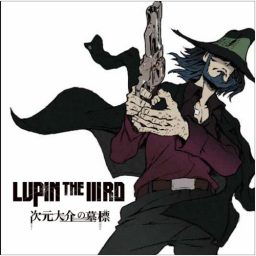50 YEARS OF LUPIN III: Daisuke Jigen’s Gravestone
Monday , 17, July 2017 Art, Comics, Movies 2 Comments I owe you a bullet wound, and I’m going to make sure that debt gets paid. – Daisuke Jigen
I owe you a bullet wound, and I’m going to make sure that debt gets paid. – Daisuke Jigen
Nine days after Queen Malta’s assassination at a peace concert, a sniper ends Lupin III’s latest jewel heist with a well-placed shot, sending a bullet into Daisuke Jigen’s leg. The thieves crawl away to safety before the next shot could prove fatal. Acting on a hunch from a spent round, Jigen searches the nearest cemetery. A legendary gunman, Jael Okuzaki, is known to prepare a grave for each target he kills. And the newest grave is Jigen’s. As the country around him prepares for war, Jigen fights his own personal battle, gunslinger against sniper. Okuzaki knows the city and has a preternatural ability to know exactly where Jigen is at any time. All Jigen has is the revolver at his side–and the help of the world’s greatest thief, Lupin III.
A two part theatrical film released in 2014, Daisuke Jigen’s Gravestone occupies a strange spot in the Lupin III catalog. It is a rare direct continuation of a previous work, the controversial TV series The Woman Called Fujiko Mine. Intended as a daring reimagination of Lupin III, The Woman Called Fujiko Mine pushed the Lupin gang to the side, focusing on Fujiko’s self-indulgent mysteries and centerfold preening for the camera. And, like many “daring reimaginations,” the additions boiled down to the same three features: dark stories, boobs, and blood. Faced with complaints that Lupin was no longer in the spotlight, Daisuke Jigen’s Gravestone returns the focus to Lupin III and his American gunslinger buddy, Daisuke Jigen. And as a character, Lupin returns in magnificent style.

Over time, Lupin’s adventures have shifted towards more comedic affairs, playing up the clownish aspects of his portrayal to the point where live-action Lupin skits have been known to appear on Japanese comedy shows. While that clownishness is intended to disarm his foes by covering his formidable skills, it has replaced the smug air of amused mastery that filled the pages of the original manga. Daisuke Jigen’s Gravestone instead harkens back to the source material. By drawing away the curtain of comedic obfuscation, the movie gives Lupin’s skills a chance to shine, whether by tracking down Jael’s hideout by the flowers planted on Jigen’s grave, relieving Fujiko of her ill-gotten gains with a brush of his fingers, or implementing the ruses that force the final confrontation with Jael. Unlike many of today’s protagonists, Lupin does not delight in the exhibition of his skills. Instead, he is almost bored by such tasks as the challenge is beneath him. Lupin avoids Mary Sue territory as he can be out-thought and out-fought, and like a Conan, sometimes discretion and retreat are the better parts of valor. Given a proper challenge or an affront, though, and the smug amusement bubbles to the forefront as he devotes his masteries to defeating his rival–and revealing just how they were out-smarted. And rarely is all Lupin’s amusement and mastery so revealed as in this movie.

As mentioned in the comments on the Italian adventures, stories that focus on the rest of the gang tend to be shallow and one-dimensional. Daisuke Jigen’s Gravestone ran that risk by making Jigen the engine of the story. The gunslinger was Queen Malta’s bodyguard, dismissed just before the assassination. Jigen is taking the failure and the dead hard, as it is hinted that his respect for the singer might be more than professional. If so, the relationship ended as most of Jigen’s romances do. As the assassin, Jael hunts Jigen to tie up loose end, while Lupin tries to help his gruff buddy escape. At this point, the extent of Jigen’s normal characterization has been exhausted. Rather than make up new relationships or backstories that would be forgotten in the next adventure, Daisuke Jigen’s Gravestone instead removes Jigen from the plot for about half the movie, forcing a personal confrontation between Lupin and Jael in a clash that pays off the assassination of Queen Malta, Jigen’s disappearance, and the MacGuffin of the story, the Calamity File stolen by Fujiko. Also different from previous stories is that Lupin and Jigen bond over this adventure. The stories of The Woman Called Fujiko Mine serve as a reimagined origin for the gang, and, true to the manga, Jigen and Lupin originally were rivals. Like many anime stories, Jigen’s defeat turned into friendship, but the trust between Lupin and Jigen so often shown in their adventures had yet to develop. Unlike the fast friendships over a cup of tea in other anime, don’t listen to their words but pay attention to their actions. There’s a manly, even soldierly, respect between the two men untainted by the now normal pandering to otaku and fujoshi preferences for homosexual subtext. The character development remains focused by the limited cast, since as is often the case, Goemon is indisposed, and Zenigata only shows up in an after-credits scene. All the time is spent on Lupin, Jigen, and Fujiko.
 While not quite recreating the feel of the manga, Daisuke Jigen’s Gravestone is the best story in the modern age of the franchise (which began in 2011 when the classic Japanese voice cast retired). And, by incorporating aspects of the original manga’s tone and portrayals, it should be considered a classic adventure for the franchise. Unfortunately, like The Mystery of Mamo, one scene mars it from widespread appeal, and it comes down to the same culprit in a catsuit: Fujiko Mine. While her occasional dalliances with clothing normally don’t exceed that of a Bond girl or routine anime fanservice, here it is taken a step too far. To try to build Jael’s villainy beyond that a mere assassin, Fujiko is captured, stripped naked, and placed on display for an “artistic” murder via mechanical robot to be enjoyed Eyes Wide Shut style by a bunch of bored rich nobles. As the movie lingers over Fujiko’s every scream and scare, even long time Lupin fans may find the mixing of nudity and the threat of violence distasteful, a step too far. Lupin does save the day by emptying out Club Perv, but by that time the damage to the show is done. Unlike Castle of Cagliostro or the television specials, this is not one most people would be comfortable watching in a group. It’s a shame, because the attempts to be edgy really do ruin the promise of the entire The Woman Called Fujiko Mine franchise. Especially after the moe crash, there is a need for mature stories featuring adult characters and motivations. And if Fujiko had to endure a different peril, one not driven by the perversions of weird menace, Daisuke Jigen’s Gravestone would have been a perfect fit for that need.
While not quite recreating the feel of the manga, Daisuke Jigen’s Gravestone is the best story in the modern age of the franchise (which began in 2011 when the classic Japanese voice cast retired). And, by incorporating aspects of the original manga’s tone and portrayals, it should be considered a classic adventure for the franchise. Unfortunately, like The Mystery of Mamo, one scene mars it from widespread appeal, and it comes down to the same culprit in a catsuit: Fujiko Mine. While her occasional dalliances with clothing normally don’t exceed that of a Bond girl or routine anime fanservice, here it is taken a step too far. To try to build Jael’s villainy beyond that a mere assassin, Fujiko is captured, stripped naked, and placed on display for an “artistic” murder via mechanical robot to be enjoyed Eyes Wide Shut style by a bunch of bored rich nobles. As the movie lingers over Fujiko’s every scream and scare, even long time Lupin fans may find the mixing of nudity and the threat of violence distasteful, a step too far. Lupin does save the day by emptying out Club Perv, but by that time the damage to the show is done. Unlike Castle of Cagliostro or the television specials, this is not one most people would be comfortable watching in a group. It’s a shame, because the attempts to be edgy really do ruin the promise of the entire The Woman Called Fujiko Mine franchise. Especially after the moe crash, there is a need for mature stories featuring adult characters and motivations. And if Fujiko had to endure a different peril, one not driven by the perversions of weird menace, Daisuke Jigen’s Gravestone would have been a perfect fit for that need.
The Woman Called Fujiko Mine reimagining continues with 2017’s The Blood Spray of Goemon Ishikawa, which has yet to have an English release scheduled. While future movies in this series are unconfirmed, the appearance of Mamo at the end of Daisuke Jigen’s Gravestone suggests that the blue-skinned villain in Lupin’s first film The Mystery of Mamo may return in the future.

Seems like an interesting movie.
I’ve noticed that a lot of venerable anime franchises like to release a series of OVAs or even theatrical movies to celebrate major milestones. Hokuto No Ken was another one; those tended to get better as they went along, which might be a good portent for the Lupin movies.
And heh, the attempt to kill Fujiko in front of perverts sounds like something more suited to Golgo 13. Although in that series, she would have certainly died.